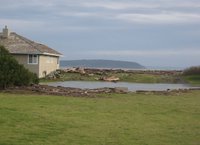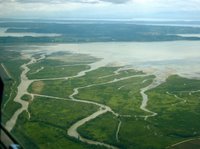skip to main |
skip to sidebar


Camano Island State Park, the day after the big storm. Sunshine and lots of fresh gravel on the backside of the barriers. The most dramatic overwash was at the south end, but there was evidence of gravel being moved across the berm all the way north past the boat ramp. Farther north at Saratoga Shores, the same basic thing happened, except that the waves had to throw the gravel over the bulkheads to get it where it belonged.
In nature, as in art. Or is it the other way around?
The one with the sediment is the south fork of the Skagit. The other one is in Yaletown, on the north side of False Creek in Vancouver.
 View south along the west side of Whidbey Island. Perego's Lagoon in the distance (note: this picture was taken several years ago).
View south along the west side of Whidbey Island. Perego's Lagoon in the distance (note: this picture was taken several years ago).


I stopped at Redondo late one afternoon last week, taking advantage of a rare break in the weather.
The Redondo seawall was hit hard by the severe northerly storms of 1990, leaving the road that parallels the beach partially closed to traffic. After much wrangling -- some of it related to environmental concerns, some of it related to funding, but much of it related to conflict between beach residents and regular users of the road -- the mile-long seawall was rebuilt with a walkway hung over the edge.
In the 1920's, Redondo was the site of a popular amusement park and a dance hall. The dance hall was later converted to a skating rink, but burned down in 1951. During the 1990s, I recall community members describing how the beach had dropped many feet over the decades since those early days. Geologically, this makes sense. The beach would have continued to erode with or without a seawall and the result would have been less and less beach in front of the wall. Erosion may have been aggravated by the loss of natural sediment sources as local bluffs were bulkheaded, although Redondo and other local creeks may have continued to deliver sediment until the modern era of good development practices and sediment detention ponds began to dry up upland sources.
But just to prove that nature is never simple, I noted that the beach at the north end, toward the boat ramp and piers, looks like it has built up appreciably (see photo beneath walkway). I haven't been down here enough to know if this has been gradual, or whether it reflects a recent event.Paul Dorpat on Redondo (link added 4-21)


















